MORE OF MY FAVORITE TH . . . GRAPE VARIETIES
The Birds and the B . . . Vespids
Hot and dry. What great summer weather it’s been here for grapes. Most years around this date, I’d go out every morning and pick bunches for fresh eating, continuing to do so for weeks to come.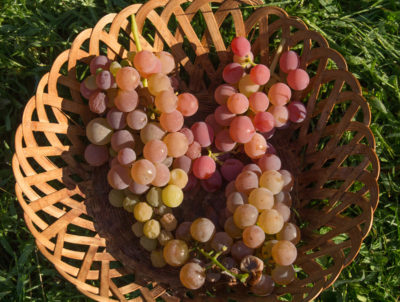
Alas, where there are grapes, you’ll find the birds and the be. . . vespids (the family of wasps and hornets, not bees). No raccoons or foxes, here on my grapes, at least. Here you’ll also find paper bags stapled around about a hundred bunches.
The bags are meant to protect the enclosed bunches from birds and insects. This year was a first: Thirsty birds pecked holes in the bags through which they could reach, then peck at the grapes hanging within. By my estimate, about three-quarters of the bagged bunches suffered damage or were finished off in toto.
In addition to the damage inflicted by the birds, the resulting holey bags provide easy entrance to wasps and hornets, who further tear up the bag and finish off the fruit repast started by birds.

ARS pruner used to pick grapes without getting stung
One saving grace is that European hornets are sparse this year. These giant hornets are mostly benign to us but enjoy fruit as much as I do. 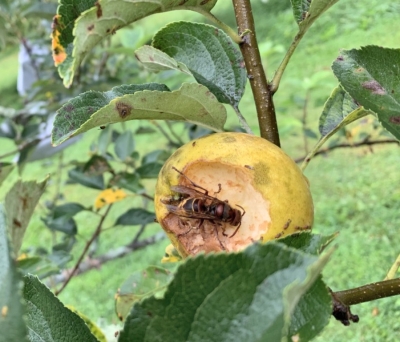 In past years, what looked on one side to be a perfectly ripe apple or plum would turn out to be just skin with some attached flesh removed from a large hole on the opposite side. One year I thought organza bags around grape bunches would keep all pests at bay. The European hornets chewed large openings in the bags, then moved onto the fruit.
In past years, what looked on one side to be a perfectly ripe apple or plum would turn out to be just skin with some attached flesh removed from a large hole on the opposite side. One year I thought organza bags around grape bunches would keep all pests at bay. The European hornets chewed large openings in the bags, then moved onto the fruit.
The Winners, Here at Least
The grapes I pick here aren’t Concord, Niagara, and the usual varieties. I chose them from among the more than 5,000 or so existing grape varieties. Well, not really. I couldn’t choose from among all 5,000 varieties because many varieties would not grow here. I seek out varieties that are cold-hardy, pest resistant, and flavorful.
Grapes that grow best here are those derived from fox grapes (Vitis labrusca) and other species native to this part of the world. Concord is the archetypal fox grape, with a slip skin, a jelly-like flesh, and that distinctive, foxy flavor. Muscadine grapes (V. rotundifolia) are native to the Southeast, so aren’t hardy here. Most varieties of European wine grapes, also called vinifera grapes (Vitis vinifera) also can’t stand up to our winter cold, and if that doesn’t do them in, grape diseases (such as black rot) and insects (such as phylloxera, as bad as it sounds) found in the Northeast do.
Breeding and selection have resulted in plenty of grape varieties adapted here and everywhere, and, over the years, I’ve planted some of the best candidates, ripping out any that didn’t make the grade and planting new ones. Many of my favorites come from the amateur breeding work of Minnesota dairy farmer Elmer Swenson: Edelweiss (very foxy and sweet);
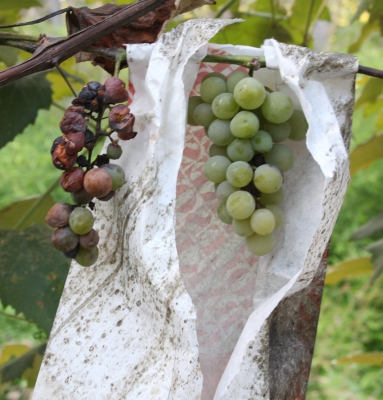
Edelweiss, bagged and not bagged
Swenson’s Red (crunchy, for a grape, and sweet); Somerset Seedless (delicious, but yields almost nothing unless bagged); and Brianna (perhaps my favorite). New this year, also thanks to Elmer, are Alpenglow (flavorful and seeded, but the small seeds can be ignored), and Bluebell (rich flavor).
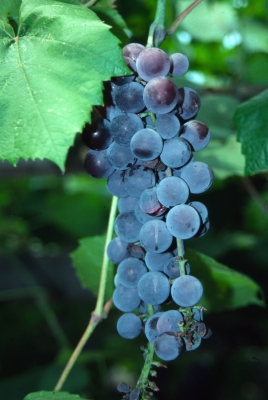
Swenson Red grape
A few years ago I tasted a number of grapes at the USDA grape collection in Geneva, NY. One variety that impressed me but I had never heard of was the variety Wapanuka. Turns out that it’s the work of eminent Texas Grape breeder T. V. Munson in 1893. Quoting from the description of Wapanuka from the web page of Graystone College, home of the T. V. Munson Memorial Vineyard, “Undoubtedly one of the best, if not the best, table and eating grapes produced in the United States.” I’ve found it to be disease resistant and prolific with flavorful, large berries, definitely a keeper. Reputedly good both North and South.
Losers, and a Special Winner
Many grape varieties have come and gone here. Vanessa (not Elmer’s handiwork) was beautiful, tasty and seedless, but too susceptible here to cold and disease, so I’m retiring her. Campbell’s Early was similar to Concord, but much earlier, with robust leaves, stems, berry clusters, and mediocre flavor. Alden has been a favorite for its sweet flavor and meaty texture, but it’s too prone to disease; out it goes this year.
A few years ago, I gave Duchess and Winchell grapes a shot at becoming members of the Springtown Farmden grape family. Both were reasonably good but Duchess died back one winter, so its new sprouts were not welcomed back in training, Winchell berries were too small with seeds too large. Their space along my grape trellis could be better used by better grapes.
I’ve also had high hopes for Mars, New York Muscat, and Reliance. Mars was too insect prone, New York Muscat’s was a muscat only in name, not flavor, And Reliance just didn’t taste good.
Just about all the above varieties have some amount of European wine grape in their predominantly fox grape heritage.
On the recommendation of my grape-knowledgeable, Hungarian friend Lev, I went to great effort to get propagating wood for the pure V. vinifera variety Perle de Csaba. (A Hungarian viticulturalist developed it in 1904.) After a few years, I had two vines in pots and ready to fruit, one of which I gave to Lev. Delicious: sweet, delicately perfumed, and seedless.
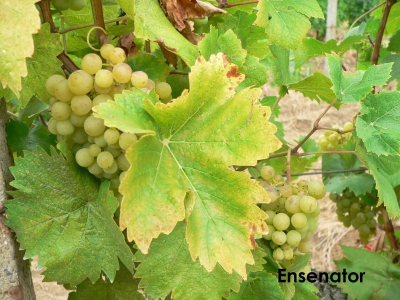
Perle de Csaba grape
One vinifera grape variety is enough for me. I grow this variety in a pot so that it can be moved to protected storage for winter, and in my greenhouse to protect it from insects and diseases, such as the aforementioned phylloxera. I may even give Perle de Csaba a permanent home in the greenhouse.


I’ve found it’s helpful to have plenty of watering spots for the birds to drink.
I see that you have Wapanuka grapes available at your plant sale this weekend. I’ve looked around the web for hardiness info. I’m north of syracuse, NY in a zone 5 (recently zoned-up from 4B).. and was wondering about their ability to thrive in the colder temps. Thanks!
I’m very sure they would be hardy at your site. I was recently in Zone 5 and not sure if I shouldn’t still be classified in that zone. The last few winters have been mild but here winter lows were typically minus 20 degrees F. The plant grows and fruits in the USDA collection in Geneva, NY.